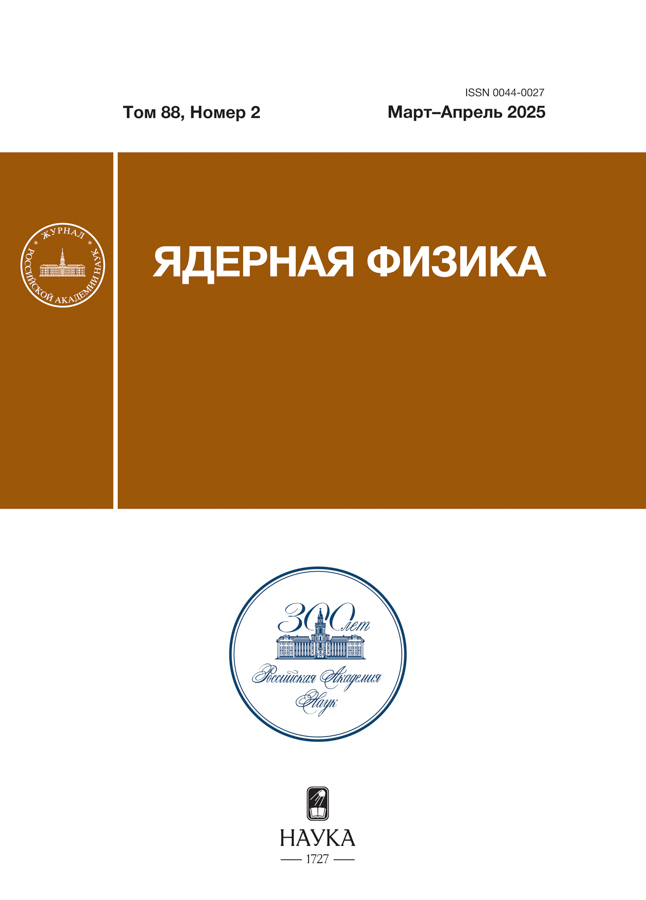ФРАГМЕНТАЦИЯ ЯДЕР ПОД ВОЗДЕЙСТВИЕМ РАДИАЦИОННЫХ ИЗЛУЧЕНИЙ РАЗЛИЧНОГО ТИПА
- Авторы: Новиков Н.В.1, Чеченин Н.Г.1, Широкова А.А.1
-
Учреждения:
- Московский государственный университет им. М.В. Ломоносова, Научно-исследовательский институт ядерной физики им. Д.В. Скобельцына
- Выпуск: Том 86, № 2 (2023)
- Страницы: 361-368
- Раздел: МАТЕРИАЛЫ LXXII МЕЖДУНАРОДНОЙ КОНФЕРЕНЦИИ “ЯДРО-2022: ФУНДАМЕНТАЛЬНЫЕ ВОПРОСЫ И ПРИЛОЖЕНИЯ”. Элементарные частицы и поля. Эксперимент
- Статья опубликована: 01.04.2023
- URL: https://cardiosomatics.ru/0044-0027/article/view/674719
- DOI: https://doi.org/10.31857/S0044002723020150
- EDN: https://elibrary.ru/RJTWGQ
- ID: 674719
Цитировать
Полный текст
Аннотация
Предложена аналитическая аппроксимация для определения распределения неупругих потерь энергии заряженных фрагментов ядерных реакций в столкновении протонов, гамма-квантов и электронов с ядром кремния. Показано, что в диапазоне энергии 3–10 ГэВ влияние процесса адронизации на это распределение для вторичных тяжелых ионов возрастает с увеличением энергии падающего излучения. Сильная асимметрия рассчитанного распределения при столкновениях с релятивистскими электронами указывает на передачу импульса только небольшому фрагменту ядра.
Об авторах
Н. В. Новиков
Московский государственный университет им. М.В. Ломоносова, Научно-исследовательский институт ядерной физики им. Д.В. Скобельцына
Email: nvnovikov65@mail.ru
Россия, 119991, Москва
Н. Г. Чеченин
Московский государственный университет им. М.В. Ломоносова, Научно-исследовательский институт ядерной физики им. Д.В. Скобельцына
Email: nvnovikov65@mail.ru
Россия, 119991, Москва
А. А. Широкова
Московский государственный университет им. М.В. Ломоносова, Научно-исследовательский институт ядерной физики им. Д.В. Скобельцына
Автор, ответственный за переписку.
Email: nvnovikov65@mail.ru
Россия, 119991, Москва
Список литературы
- Г. И. Зебрев, Радиационные эффекты в кремниевых интегральных схемах высокой степени интеграции (НИЯУ МИФИ, Москва, 2010).
- Модель космоса. Воздействие космической среды на материалы и оборудование космических аппаратов, Под ред. Л. С. Новикова (Изд-во КДУ, Москва, 2007), т. II.
- С. Г. Рубин, Устройство нашей вселенной (Век2, Фрязино, 2006).
- М. И. Панасюк, Странники Вселенной или эхо Большого взрыва (Век2, Фрязино, 2005).
- Nuclotron-based Ion Collider fAcility (NICA), https://nica.jinr.ru/ru/
- STAR Collab. (J. Adams, M. M. Aggarwal, Z. Aham- med, J. Amonett, B. D. Anderson, D. Arkhipkin, G. S. Averichev, S. K. Badyal, Y. Bai, J. Balewski, O. Barannikova, L. S. Barnby, J. Baudot, S. Bekele, V. V. Belaga, et al.), Nucl. Phys. A 757, 102 (2005).
- G. Aad et al. (ATLAS Collab.), Phys. Lett. B 716, 1 (2012).
- S. Chatrchyan et al. (CMS Collab.), Phys. Lett. B 716, 30 (2012).
- H. Yamamoto, Symmetry 13, 674 (2021).
- А. Г. Ситенко, Теория ядерных реакций (Энергоатомиздат, Москва, 1983).
- H. W. Bertini, Phys. Rev. 131, 1801 (1963).
- Н. В. Новиков, Н. Г. Чеченин, Т. В. Чувильская, В. Я. Чуманов, А. А. Широкова, ЯФ 84, 315 (2021).
- Б. С. Ишханов, И. М. Капитонов, Взаимодействие электромагнитного излучения с атомными ядрами (Изд-во МГУ, Москва, 1979).
- J. F. Ziegler, M. D. Ziegler, and J. P. Biersack, Nucl. Instrum. Methods B 268, 1818 (2010).
- J. Allison, K. Amako, J. Apostolakis, P. Arce, M. Asai, T. Aso, E. Bagli, A. Bagulya, S. Banerjee, G. Barrand, B. R. Beck, A. G. Bogdanov, D. Brandt, J. M. C. Brown, H. Burkhardt, Ph. Canal, et al., Nucl. Instrum. Methods A 835, 186 (2016).
- A. J. Koning and D. Rochman, Nucl. Data Sheets 113, 2841 (2012).
Дополнительные файлы















